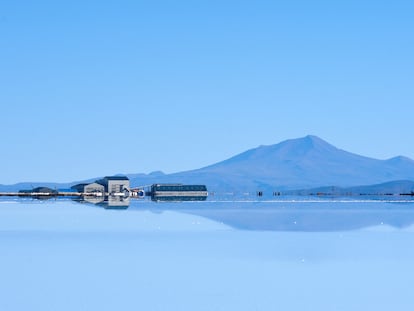Latin America is part of the solution to major global challenges
The region is well positioned to be part of the solution to the main global challenges, including climate change, food security and preserving biodiversity

If there were ever a cliché about Latin America, it’s that the region is a continent of “lost decades” and “missed opportunities.”
Indeed, Latin America has long posted one of the world’s lowest economic growth and one of its highest income inequality rates. These are daunting challenges and a priority for the region to address.
But what’s less apparent is that the region is starting to develop in areas that are critical to the entire planet’s future. Latin America is now perfectly positioned to be part of the solution for the world’s biggest challenges, including climate change, food insecurity, and biodiversity preservation.
So, the region is at a crossroads, a potential inflection point at which its future could change.
But the region and its partners need to seize this unprecedented opportunity.
As leaders from the Latin America and the Caribbean and Europe gather at a summit in Brussels next week to enhance their ties, they should explore ways to help realize this opportunity by promoting policies that provide adequate financing, incentivize physical and digital investment and productivity growth, improve regulatory frameworks, build capacity and training, enhance planning, all in crucial areas.
Let me highlight a few of the areas where the region is starting to develop and has enormous potential.
First, the region is becoming a clean energy powerhouse. Today, almost 30% of its energy comes from renewables, double the world average. In Central America, that figure is 80%. With the right tools and incentives, in due time the region could lead the globe in exporting clean energy.
Chile, Colombia and Costa Rica, for example, already announced three of the six best climate strategies in the world, according to Climate Action Tracker.
Latin America’s clean energy matrix gives it a competitive advantage in producing clean fuels, like green hydrogen, for both domestic and global use.
Chile, for example, is betting big on a green future. It aims to produce the world’s least expensive green hydrogen by 2030 and be a top exporter by 2040.
We expect demand for hydrogen to remain firm for the foreseeable future. So do others. Last month, the European Union announced it would provide over $200 million in grants and loans to back Chile’s potential. That is creating opportunities for local, regional and international companies that want to go green and ensure their supply chains are sustainable.
Brazil, which has one of the world’s least carbon-intensive energy sectors, is also pursuing an ambitious green hydrogen program. We estimate that by 2050 Brazil could export 4 million tons a year of it.
Brazil is also becoming a climate leader in other areas. With just 3% of the world’s population, it already accounts for 7% of its renewable energy output. It also ranks second worldwide in creating renewable energy jobs and last year it installed more new wind power plants than any country except China and the United States.
Second, the region is home to some of the world’s greatest natural resources, including the Amazon rainforest. The Amazon alone absorbs a quarter of all the CO2 absorbed by the entire planet, mitigating climate change for the whole world. But the Amazon is at risk and time is of the essence.
Protecting the Amazon is about engaging its native communities, and also fostering its business. In fact, the right approach could boost local GDP by over $8 billion annually by 2050 and create over 800,000 jobs in the bioeconomy and other areas, according to new research from the World Resources Institute.
Because of this, we are launching an Amazonía Forever umbrella program that coordinates initiatives and takes a holistic, regionwide approach to preserving the forest while incentivizing sustainable economic development in the region
Third, Latin America can help alleviate food insecurity, another important global public good. The region is already the world’s top net food exporter and produces enough to feed up to 1.3 billion people, double its population. With the right frameworks and reforms , it could dramatically boost output while protecting its ecosystems, reducing food insecurity in the region and, importantly, globally.
Finally, the region also has unmatched potential to help the world face climate change by tapping into its remarkably rich raw materials.
Latin America has significant nickel and graphite reserves and is home to two-thirds of the world’s lithium and 38% of its copper, crucial to produce electric vehicles and the green transition. Investors are taking notice.
Argentina, which has several working lithium mines and another 38 in the works, is now the world’s fastest-growing lithium producer. With the right policies, we estimate Latin America could export $50 billion annually by 2050 while helping the world meet its net-zero goals.
The region’s green transition is creating opportunities for local, regional and international companies that also want to go green and ensure their supply chains are sustainable.
For example, German automaker Volkswagen moved to sell electric vehicles in Uruguay partly because the country runs almost entirely on clean energy. This helps Volkswagen meet its own carbon neutrality targets.
European firms could also turn to the region to comply with a proposed EU supply chain law establishing corporate sustainability requirements.
Many of the region’s climate investments also address other key EU priorities, including digitalization and gender equality, for example by training women to build solar power panels.
Seizing this opportunity means also creating much needed jobs. We estimate the region’s transition to a net-zero economy could also create 15 million net jobs. In Chile, it could increase GDP by 5% while adding $336 billion to Colombia’s economy and over $100 billion in Peru.
Doing what’s right for the planet is turning out to be good for business for Latin America and the Caribbean and its public and private partners.
The region of “lost decades” has found an immense opportunity. Let’s be sure to seize it.
Tu suscripción se está usando en otro dispositivo
¿Quieres añadir otro usuario a tu suscripción?
Si continúas leyendo en este dispositivo, no se podrá leer en el otro.
FlechaTu suscripción se está usando en otro dispositivo y solo puedes acceder a EL PAÍS desde un dispositivo a la vez.
Si quieres compartir tu cuenta, cambia tu suscripción a la modalidad Premium, así podrás añadir otro usuario. Cada uno accederá con su propia cuenta de email, lo que os permitirá personalizar vuestra experiencia en EL PAÍS.
¿Tienes una suscripción de empresa? Accede aquí para contratar más cuentas.
En el caso de no saber quién está usando tu cuenta, te recomendamos cambiar tu contraseña aquí.
Si decides continuar compartiendo tu cuenta, este mensaje se mostrará en tu dispositivo y en el de la otra persona que está usando tu cuenta de forma indefinida, afectando a tu experiencia de lectura. Puedes consultar aquí los términos y condiciones de la suscripción digital.
More information
Archived In
Últimas noticias
Most viewed
- Sinaloa Cartel war is taking its toll on Los Chapitos
- Oona Chaplin: ‘I told James Cameron that I was living in a treehouse and starting a permaculture project with a friend’
- Reinhard Genzel, Nobel laureate in physics: ‘One-minute videos will never give you the truth’
- Why the price of coffee has skyrocketed: from Brazilian plantations to specialty coffee houses
- Silver prices are going crazy: This is what’s fueling the rally










































